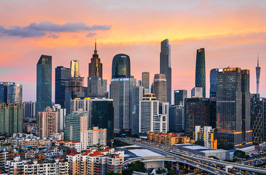Coastal protection building 'city of mangroves'
Home to more than a third of all China's mangrove forests, Zhanjiang, located on the southernmost peninsula of the Chinese mainland, is aiming to become "a city of mangroves", according to the local government.
Mangroves are shrubs or trees that grow in shallow coastal waters. There are almost 10,000 hectares of mangroves in Zhanjiang, accounting for 33 percent of China and 78 percent of Guangdong province.
Bucking the global trend of mangrove decline, in recent years the Zhanjiang government has added an extra 2,000 hectares of mangroves to its coastline, a fact widely recognized by international bodies that work for their protection.
The mangroves in Zhanjiang are home to a great deal of biodiversity, with 235 species of birds recorded there and 33 species listed as key protected wild animals.
The Zhanjiang Mangrove National Nature Reserve is the biggest single mangrove forest in China, and is not only home to flocks of migratory birds year-round, but is also a paradise for fish, shrimp, crab and shellfish.

Egrets fly over mangrove forests in Zhanjiang. LIU JICHENG/FOR CHINA DAILY
Mangroves have come to symbolize the city of Zhanjiang, and so the government has gone to great lengths to protect, preserve and grow its mangrove forests so as to truly become "a city of mangroves".This desire was reaffirmed on Dec 30, 2021, during a government meeting held to discuss future action to protect, restore and make even better use of the forests.
Liu Hongbing, Party secretary of Zhanjiang, said the city should fully tap into the ecological advantages of mangroves, strengthen protection efforts and create new business models around them.
Early last year, an expanse of mangrove swamp in the city became the foundation for China's first blue carbon credit project, the first of its kind successfully developed and registered in China.
The city is working on ocean carbon sink accounting and a pilot study of carbon sink budgeting, aiming to develop the first provincial-level "Zhanjiang standards" of mangrove carbon sink accounting and will include the city's mangrove carbon sink in Guangdong's voluntary emission reduction program.
Through making full use of the mangrove resources, the local economy will be boosted in forms such as ecological tourism, the carbon sink economy and fish farming, Liu said.
Liao Baowen, head of a mangrove research center, said that building "a city of mangroves" will have an effective demonstration effect in the protection, restoration and utilization of mangroves across the country and worldwide.
The research center hopes to strengthen cooperation with the city government in mangrove protection and continue to play an important role in the ecological restoration and monitoring of mangroves.
Apart from mangrove protection, Zhanjiang has made notable progress in improving the local environment in general and maintaining sustainable development, officials said.
According to data from the city's environmental protection bureau, the city kept its air quality ahead of other cities in Guangdong. Ninety-eight percent of all days in 2021 met the requirements of the Air Quality Index, up 1.7 percent year-on-year.
The annual average concentration of six major pollutants-PM2.5, PM10, sulfur dioxide, nitrogen dioxide, carbon monoxide and ozone remained above standard.
As a harbor city, Zhanjiang attaches great importance to the quality of its coastal waters, adhering to the overall action of pollution prevention and control in both land and coastal areas.
The concentration of main pollutants in Zhanjiang Bay dropped from 2020, according to the data. Jinsha Bay, a famous attraction in the city, is rated as one of the 10 most popular and beautiful beaches in Guangdong province.



 Print
Print Mail
Mail

